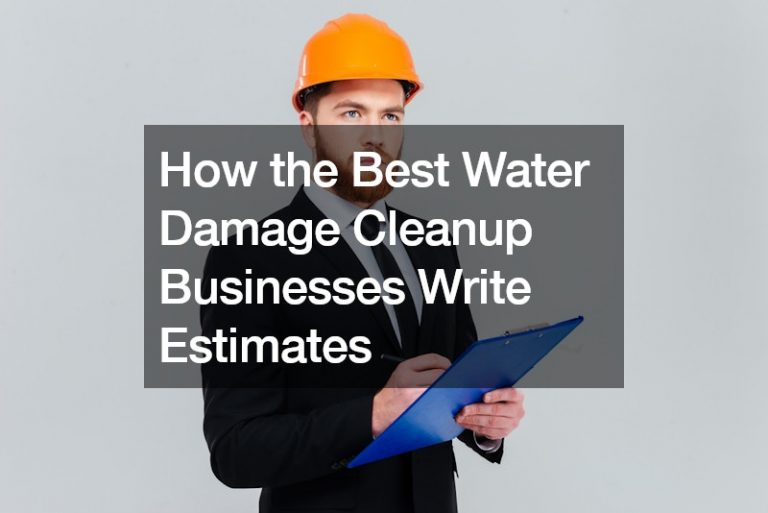Water damage cleanup businesses often face challenges in accurately estimating jobs while ensuring profitability. Effective estimation is crucial for both maximizing revenue and maintaining positive relationships with adjusters. In this article, we’ll explore how the best water damage cleanup businesses write estimates, incorporating alternative methods and debunking common myths.
Key Parts of Water Damage Cleanup Estimates
Scope of Work: The estimate begins with a detailed description of the scope of work to be performed. This section outlines the specific tasks and services the cleanup company will undertake to address the water damage effectively.
It may include tasks such as water extraction, drying, sanitization, demolition of damaged materials, and restoration.
Assessment of Damages: A thorough assessment of the damages is essential for accurately estimating the extent of the cleanup and restoration efforts required. This assessment may involve inspecting affected areas, identifying moisture levels, assessing structural damage, and evaluating the potential for mold growth.
Materials and Equipment: The estimate itemizes the materials and equipment necessary to complete the cleanup process. This includes items such as water extraction equipment, drying machines, dehumidifiers, protective gear, cleaning solutions, and any specialized tools required for the job.
Labor Costs: Labor costs are a significant component of the estimate and are typically calculated based on the number of hours required to complete the cleanup and restoration tasks. The estimate may specify the hourly rate for labor and provide an estimate of the total labor costs based on the projected duration of the project.
Disposal and Waste Removal: In cases where damaged materials need to be removed and disposed of properly, the estimate includes the cost of disposal and waste removal services. This may involve removing waterlogged materials such as drywall, insulation, carpeting, and furniture, as well as disposing of any hazardous waste in compliance with regulations.
Documentation and Reporting: The estimate may outline the documentation and reporting procedures that will be followed throughout the cleanup process. This may include documenting the initial assessment findings, progress reports, photographs of the damage, and a final report detailing the completed work.
Insurance and Billing Information: If the customer is filing an insurance claim for the water damage cleanup, the estimate may include relevant insurance and billing information. This may include details on how the cleanup company will work with the customer’s insurance provider, including billing procedures and any necessary documentation.
Terms and Conditions: Finally, the estimate typically includes terms and conditions outlining the rights and responsibilities of both parties, including payment terms, warranties or guarantees on the work performed, and any applicable legal disclaimers.
Challenge Conventional Wisdom:
It’s essential for water damage cleanup businesses to question traditional industry practices. Instead of blindly following outdated advice, successful businesses assess what truly works based on their experiences. By challenging conventional wisdom, these businesses can discover more efficient and profitable ways of operating.
Dispelling Myths:
One prevalent myth in the water damage cleanup industry is the necessity of providing detailed sketches with estimates. Contrary to popular belief, sketches are not always required and can sometimes lead to unnecessary complications. Businesses that understand this myth debunk it by adopting alternative approaches to estimating, focusing on clarity and transparency without excessive detail.
Alternative Estimation Methods:
The best water damage cleanup businesses employ alternative estimation methods to streamline their processes and improve accuracy. One such method is the “muddy scope,” which offers a story-based estimate that provides transparency while avoiding unnecessary complexity. By focusing on the essential aspects of the job without getting bogged down in minutiae, businesses can create estimates that are easy to understand and negotiate with adjusters.
Billing Strategies:
Effective billing strategies play a crucial role in ensuring profitability for water damage cleanup businesses. Instead of adhering strictly to hourly rates or unit pricing, successful businesses explore alternative billing methods. For example, charging by the trip rather than hourly for monitoring services can simplify billing and potentially lead to higher revenue. Additionally, lumping services into single-line items on invoices can streamline the billing process and reduce disputes with adjusters.
Value-Based Pricing:
The best water damage cleanup businesses prioritize value-based pricing, charging rates that reflect the value delivered to customers. By focusing on the outcomes of their services rather than just the time and materials involved, businesses can justify higher prices and increase profitability. This approach requires businesses to effectively communicate the value they provide to customers, which can lead to stronger relationships and repeat business.
Training Opportunities:
Ongoing training and professional development are essential for water damage cleanup businesses to stay ahead of the curve. Investing in training programs, workshops, and industry events allows businesses to learn new techniques, stay updated on industry trends, and network with other professionals. For example, attending a water damage boot camp event can provide valuable hands-on training and insights into advanced restoration business management strategies.
In conclusion, the best water damage cleanup businesses prioritize effective estimation practices to maximize profitability and maintain positive relationships with adjusters. By challenging conventional wisdom, adopting alternative methods, and focusing on value-based pricing, these businesses can achieve success in a competitive industry. Ongoing training and professional development also play a vital role in staying ahead of the curve and delivering exceptional service to customers.
.











